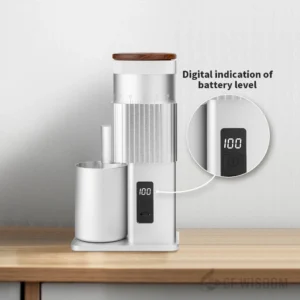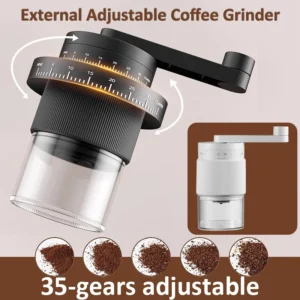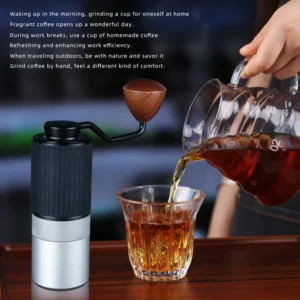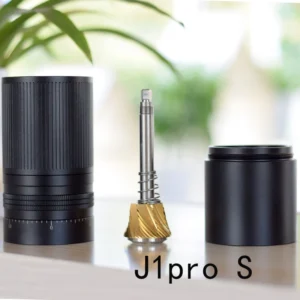Fine Adjustment Hand Grinder
Grind with precision for your best coffee. Fine adjustment hand grinders give exact control for ideal extraction, delivering rich, consistent flavor from espresso to French press.
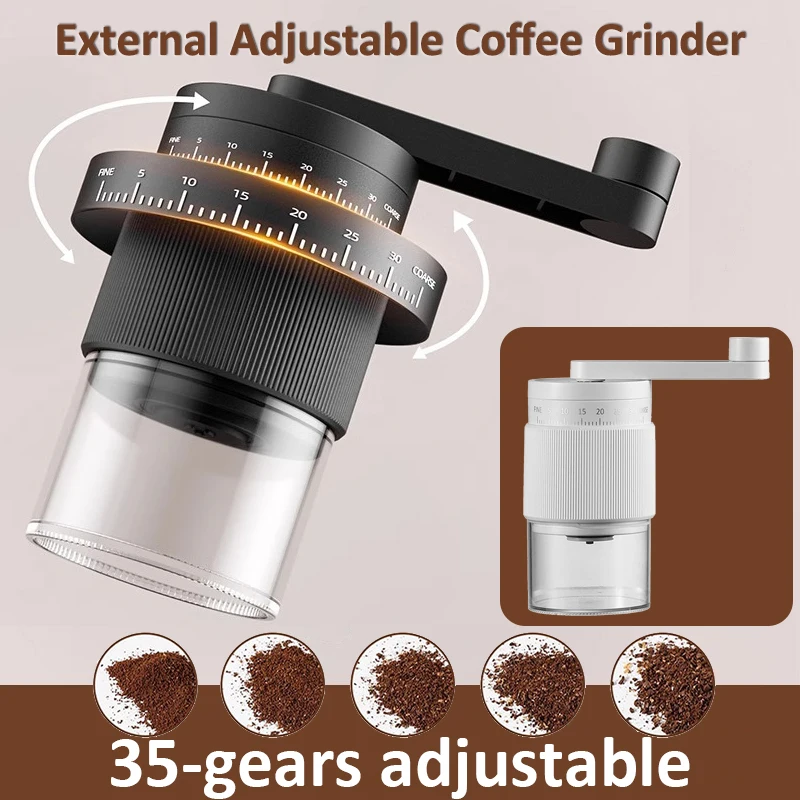
Showing all 4 results
Fine Adjustment Hand Grinder, Precision Manual Grinder, Travel Coffee Grinder
Price range: $313.00 through $377.20 Select options This product has multiple variants. The options may be chosen on the product pageCeramic Burr Coffee Grinder, Fine Adjustment Hand Grinder, Manual Coffee Bean Grinder, Manual Coffee Mill Grinder
Price range: $62.70 through $65.28 Select options This product has multiple variants. The options may be chosen on the product pageFine Adjustment Hand Grinder, Hand Burr Grinder, Manual Burr Mill, Manual Coffee Bean Grinder
Price range: $68.86 through $70.72 Select options This product has multiple variants. The options may be chosen on the product pageFine Adjustment Hand Grinder, Precision Manual Grinder, Travel Coffee Grinder
Price range: $185.11 through $494.63 Select options This product has multiple variants. The options may be chosen on the product page
Showing all 4 results
Understanding Fine Adjustment Hand Grinders
Fine adjustment hand grinders represent the pinnacle of manual coffee grinding precision, offering control measured in microns per click. Unlike basic hand grinders, these sophisticated tools allow you to make minute adjustments to your grind size, creating the perfect foundation for exceptional coffee. This precision directly impacts extraction – the process where water pulls flavor compounds from your coffee grounds.
At Savor Suite, we understand that the difference between a good cup and an extraordinary one often comes down to grind consistency and size control. Fine adjustment grinders excel by offering repeatable settings and exceptional particle uniformity, allowing you to confidently dial in your perfect cup. Whether you’re brewing espresso that demands ultra-fine grounds or pour-over that requires medium-fine consistency, these grinders provide the versatility and control needed for brewing excellence.
The Science of Extraction and Grind Size
Coffee extraction is fundamentally about dissolving flavor compounds from ground coffee. Grind size directly controls how quickly this happens – too coarse and water flows through too quickly (under-extraction), creating sour, weak coffee. Too fine and water flows too slowly (over-extraction), producing bitter, harsh flavors.
The ideal extraction typically falls between 18-22% of the coffee’s soluble compounds. Fine adjustment grinders shine here because they allow you to make tiny, deliberate changes to find that sweet spot. A minor adjustment of just 1-2 clicks can transform your brew from acceptable to exceptional.
Consistent particle size is equally crucial – when grounds are uniform, they extract at the same rate. Fine adjustment grinders minimize “fines” (dust-like particles) and “boulders” (oversized chunks) that cause uneven extraction and muddled flavors.
Precision Requirements Across Brewing Methods
Different brewing methods demand specific grind sizes and consistency levels:
Espresso: Requires ultra-fine grounds (200-400 microns) with micro-adjustments between shots. Fine adjustment is critical here as even 50-micron differences can dramatically alter extraction time and flavor.
Pour-over: Benefits from medium-fine grounds (400-700 microns) with precise consistency for even extraction and clean flavor separation.
AeroPress: Offers incredible versatility, using grinds from fine to medium (300-800 microns) depending on your recipe and desired strength.
French press: Needs coarse but uniform grounds (800-1000 microns) to prevent silt passing through the mesh filter.
Premium precision manual grinders excel by offering the range and consistency needed across these brewing styles, often outperforming many electric grinders in consistency at these critical particle sizes.
Types of Adjustment Mechanisms
Fine adjustment grinders typically feature one of two adjustment systems:
Stepped adjustment: Offers distinct “clicks” as you turn the adjustment dial, with each click representing a specific grind size change (typically 8-25 microns per click). These provide excellent repeatability – you can count clicks to return to previous successful settings.
Stepless adjustment: Provides infinite adjustment possibilities without fixed positions, allowing for the ultimate precision when dialing in espresso. However, finding exact previous settings can be more challenging.
The physical mechanism may be:
– External adjustment: Dials or knobs on the outside of the grinder that allow quick changes but may shift during grinding
– Internal adjustment: More stable systems requiring partial disassembly but offering exceptional consistency once set
The finest grinders often provide 10 microns or less per adjustment increment, allowing for truly precise control over your coffee extraction.
Essential Components of Premium Hand Grinders
The heart of any fine adjustment grinder is its burr set:
– Material: Stainless steel manual coffee grinders offer exceptional durability and cutting precision, while ceramic burr coffee grinders resist heat and maintain sharpness longer.
– Geometry: Precision-machined burrs with sharp cutting edges and optimized grinding angles produce more uniform particles.
– Size: Larger burrs (30-48mm) typically grind faster and generate less heat but increase grinder size.
Equally important are stability components:
– Dual bearings to minimize axle wobble
– Precision-machined bodies (often aluminum or stainless steel)
– Rigid construction to prevent flexing during grinding
The finest grinders also balance capacity (typically 20-40g) with portability and ease of use, making them suitable for home or travel use.
Top Features to Look For
When selecting a fine adjustment hand grinder, prioritize:
- Adjustment precision: Look for systems offering 10-20 micron increments between settings
- Burr quality: Precision-machined steel or ceramic burrs from reputable manufacturers
- Construction materials: Aircraft-grade aluminum, stainless steel, or other premium metals
- Ergonomics: Comfortable handles, stable bases, and reasonable grinding effort
- Consistency performance: Minimal particle size deviation across the grind range
- Appropriate capacity: 25-40g for home use, 15-25g for travel coffee grinders
- Maintenance accessibility: Easy disassembly for cleaning and burr alignment
- Value proposition: Features justifying the investment (premium grinders typically range from $150-300)
These features directly impact your brewing results and long-term satisfaction with your purchase.
Expert-Recommended Models
Our experts categorize fine adjustment hand grinders based on their optimal use cases:
Best for Espresso:
Espresso coffee hand grinders typically feature 30-48mm conical burrs, stepless or fine-stepped adjustment (5-10 microns per click), and exceptional stability systems. Their adjustment range excels at the fine end but may sacrifice some consistency at coarser settings.
Versatile All-Around Performance:
These grinders balance precision across all brewing methods with 38-45mm burrs, 10-15 micron adjustment steps, and excellent stability. They typically offer slightly larger capacity (30-40g) and comfortable grinding for daily use.
Premium Travel Options:
Premium travel grinders feature compact designs without sacrificing adjustment precision. Look for models with collapsible handles, magnetic components, and protective cases while maintaining 30-38mm quality burrs.
Best Value for Fine Adjustment:
These provide excellent precision (typically 15-20 micron steps) at more accessible price points, often using slightly smaller burrs (30-38mm) or alternative body materials while maintaining core grinding performance.
Maintenance for Optimal Performance
To maintain precision grinding performance:
- Clean your grinder every 1-2 weeks of regular use
- Remove coffee oils with a dry brush; avoid water on metal burrs
- Periodically disassemble for deeper cleaning (quarterly)
- Check burr alignment after cleaning
- Calibrate to “zero point” (where burrs just touch) before setting grind size
- Store in a dry environment to prevent moisture damage
Proper maintenance ensures consistent grind quality and extends the life of your investment, with quality burrs often lasting 5-10 years of home use before replacement.
Frequently Asked Questions
Can fine adjustment grinders handle both espresso and French press?
Yes, premium models offer ranges from espresso-fine to French press-coarse, though some excel more at one end of the spectrum than the other.
How often should burrs be replaced?
Quality steel burrs typically last 1,500-2,000 pounds of coffee (5-10 years of home use). Ceramic burrs may last longer but are more brittle.
What’s the difference between premium and budget fine adjustment grinders?
Premium models offer greater adjustment precision, improved stability components, better burr quality, and more consistent particle size distribution.
Are manual burr mills better than electric for precision?
Top-tier manual grinders often provide better grind consistency than electric grinders under $500, with fewer fines and more precise adjustment capabilities.
How do you find the zero point when calibrating?
Slowly adjust the burrs closer together while gently turning the handle until you hear/feel the burrs just touching. This is your zero point for setting grind size.

